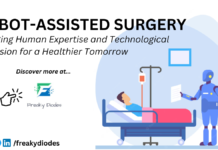Artificial Nerve Cell Researchers have used printed transistors to emulate the neurons and synapses of the biological system for artificial organic neuron
Artificial Nerve Cells, Future brain-machine interfaces, prosthetics, and intelligent soft robotics will require integrating artificial neuromorphic devices with biological systems. Due to their poor biocompatibility, circuit complexity, low energy efficiency, and operating principles fundamentally different from the ion signal modulation of biology, traditional Silicon-based neuromorphic implementations have limited bio-integration potential. Here, we report the first organic electrochemical neurons (OECNs) with ion-modulated spiking, based on all-printed complementary organic electrochemical transistors. We demonstrate facile bio-integration of OECNs with Venus Flytrap (Dionaea muscipula) to induce lobe closure upon input stimuli. The OECNs can also be integrated with all-printed organic electrochemical synapses (OECSs), exhibiting short-term plasticity with paired-pulse facilitation and long-term plasticity with retention >1000 s, facilitating Hebbian learning. These soft and flexible OECNs operate below 0.6 V and respond to multiple stimuli, defining a new vista for localized artificial neuronal systems possible to integrate with bio-signaling systems of plants, invertebrates, and vertebrates.
In 2018, researchers at the Linköping University developed complementary and printable organic electrochemical circuits having both n-type and p-type polymers, which conducted negative and positive charges. This made it possible to build printed complimentary organic electrochemical transistors. Since then, the group has subsequently optimized the organic transistors for manufacturing in printing presses on thin plastic foil. Thousands of transistors can be printed on a single plastic substrate.
Now, these researchers together with those in Lund and Gothenburg have used the printed transistors to emulate the neurons and synapses of the biological system.
“For the first time, we’re using the transistor’s ability to switch based on ion concentration to modulate the spiking frequency”, says Padinhare Cholakkal Harikesh, a post-doctoral researcher at the Laboratory of Organic Electronics, Linköping University.
The spiking frequency gives the signal that causes the biological system to react.
To demonstrate an artificial organic neuron, a nerve cell was integrated with a living plant and an artificial organic synapse. Both the neuron and the synapse were made from printed organic electrochemical transistors.
On connecting to the carnivorous Venus flytrap, the electrical pulses from the artificial nerve cell resulted in the plant’s leaves shutting – even though no-fly entered the trap. Organic semiconductors can conduct both electrons and ions, thus helping mimic the ion-based mechanism of pulse (action potential) generation in plants. In this case, the small electric pulse of less than 0.6 V can induce action potentials in the plant, which in turn causes the leaves to close.
“We chose the Venus flytrap so we could clearly show how we can steer the biological system with the artificial organic system and get them to communicate in the same language”, says Simone Fabiano, associate professor, and principal investigator in organic nanoelectronics at the Laboratory of Organic Electronics, Linköping University, Campus Norrköping.
Organic semiconductors have numerous advantages – they’re biocompatible, biodegradable, soft, and formable. They only require low voltage to operate, which is completely harmless to both plants and vertebrates. On that note, ion-based neurons can be connected to biological systems.
“We’ve also shown that the connection between the neuron and the synapse has a learning behavior, called Hebbian learning. Information is stored in the synapse, which makes the signaling more and more effective”, says Simone Fabiano.
The hope is that artificial nerve cells can be used for sensitive human prostheses, implantable systems for relieving neurological diseases, and soft intelligent robotics.
Research advancement in brain-machine interfaces, implantable/wearable devices, prosthetics, and intelligent soft robotics calls for close interaction between and integration of technology into nature. Since the fundamental building elements of life differ significantly from those utilized in electronic devices, the ability to link an artificial device with a biological system is crucial to the success of these domains.
Read here to know more… (Organic electrochemical neurons and synapses with ion mediated spiking)








